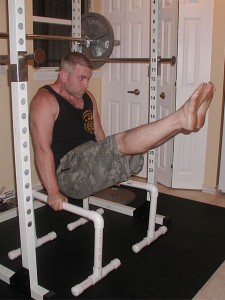 Parallettes are a gymnastics training tool which can be used to simulate some movements performed on parallel bars as well as a variety of bodyweight exercises such as L and V sits, planches and a variety of push ups and pressing movements. While various models are available commercially, they can be easily built for much less with commonly available materials such as wood or PVC piping.
Parallettes are a gymnastics training tool which can be used to simulate some movements performed on parallel bars as well as a variety of bodyweight exercises such as L and V sits, planches and a variety of push ups and pressing movements. While various models are available commercially, they can be easily built for much less with commonly available materials such as wood or PVC piping.
I built the set pictured for a little over $20 using 1 and 1/4 inch schedule 40 PVC piping in a little under 30 minutes, with nothing but a tape measure, a sharpie and a small hacksaw. Schedule 40 PVC is light weight, strong, and easy to work with. While some people recommend building them with only 1 inch PVC, a larger diameter will be stronger and more comfortable to grip. If you are very heavy you may even want to go up to 1 and 1/2 inch, although I currently weigh about 190 and mine barely flex under my weight.
Materials:
- 10 foot schedule 40 PVC pipe (I recommend a minimum diameter of 1 and 1/4 inch)
- 4 elbows
- 4 tees
- 8 caps
Tools:
- Hack saw or pipe cutter
- Tape measure
- Marker
- Miter box (optional, but highly recommended)
- PVC glue (optional)
Construction
The PVC pipe will need to be cut into 14 pieces: 2 bars, 4 uprights, and 8 feet. While the dimensions are not set in stone and you may wish to modify them, the following can be cut from a single 10 foot pipe with a few inches to spare.
- Two 18 inch pieces for the parallel bars
- Four 8 inch pieces for the uprights
- Eight 6 inch pieces for the feet
Connect the parallel bars to the uprights using the elbows, then connect the feet to the uprights using the tees and cap the ends of the feet. I recommend gluing all parts together, but you must be very careful when connecting the uprights to the parallel bars that they are in the same plane, as the glue can set very quickly. I recommend attaching the elbows to the uprights before the parallel bars, and lining them up on a flat surface before pressing them together. Connect the first upright to the parallel bar then lay them flat. After placing the glue inside the elbow on the second upright press it firmly onto the end of the parallel bar while holding all pieces flat. Assemble the feet, tees and caps separately. Once the feet are assembled, place glue inside the tee and firmly press the upright down into it while holding the feet perpendicular to the parallel bar. It helps to do this against a 90-degree corner. When you’re finished, you may want to rough up the surface of the parallel bars a little with sandpaper to improve grip.
If you travel and plan to take them with you for workouts, you may wish to skip the last step and keep the feet separate from the parallel bars and uprights so they can be disassembled and laid down flat for easier, more compact storage.

Comments on this entry are closed.
Drew, Thanks for this info… I’ve been wondering for a while what specs to use. I am in need of these.
thanks again.
Ed Jones
Ed,
You’re welcome. I actually made ours about 4 inches taller than what is listed above, but this required a second length of PVC piping. The above measurements require only one 10 foot piece of pipe. I had some extra around from a previous project and wanted the extra height for other exercises.
hey Drew, if i didn’t know you better, i would say it looks like you are doing crossfit in that pic 😉
Jonas
Thanks!